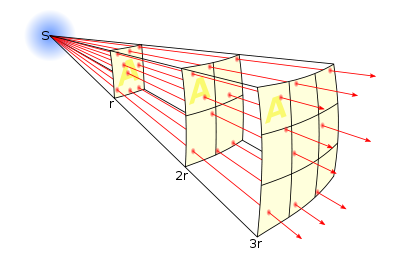So what happens in square (flat or two dimensional) space if we introduce the relationship of 1 to 2 to the relationship of 1 to 4?
The critical thing to remember about the inverse square law, is that it is when you double the distance, the field effect if it is an electric field, or the illumination if it is a light source, is reduced by the appropriate factor. Therefore the intensitity of light at distance 1 from the source is the beginning luminosity or field strength.
The same applies to sound. The loudness (strength) of the sound is said to be "inversely proportional to the square of the distance from the source".
To be semantic you may ask " In what way is it inversely 'proportional' to the square?" but that is the simplist way to state it, so you just learn the phrase. Again, it means if you stand r distance away from the source, and then stand 2r distance away, the loudness at 2r is not half the loudness at distance r, but 25%, 1/4 or the square root (2 divided by 2), or to put it another way, if you measure the sound at r (in the diag.) it will be four times as loud as at point 2r.
If you pump up the volume so that the sound at point 3r is the same as it was at 2r, and measure it again at r, it will now be 9 times as loud (3 squared) at r, as it was before you turned the volume up. I'm going over this carefully because I'm assuming that you know very little about high school physics.
This happens because the sound, or light spreads out as it travels, and falls on what we assume is the surfave of an invisible sphere. This shows that space has three dimensions. Don't ask me what the sound would be in four dimensional space, we may get to that later.
If you ask, "Why is the sound or light the same from point x, (the source) to point r the same?", we assume that it is not. The same laws apply. If we expand the scale, and divide the distance from point x, (the source) to point r, into three (x1, x2, x3), point r (x3) would be 9 times as loud as point x1, would it not? You could even assume that the same law applies to gravity, although this is not fully explained yet.
In general, the speed of sound c is given by the Newton-Laplace equation:
where
- P is a coefficient of stiffness, the bulk modulus (or the modulus of bulk elasticity for gas mediums),
- ρ is the density
Thus the speed of sound increases with the stiffness (the resistance of an elastic body to deformation by an applied force) of the material, and decreases with the density. For general equations of state, if classical mechanics is used, the speed of sound c is given by
where differentiation is taken with respect to adiabatic change.
- where p is the pressure and ρ is the density
If relativistic effects are important, the speed of sound may be calculated from the relativistic Euler equations.


The lines represent the flux emanating from the source. The total number of flux lines depends on the strength of the source and is constant with increasing distance. A greater density of flux lines (lines per unit area) means a stronger field. The density of flux lines is inversely proportional to the square of the distance from the source because the surface area of a sphere increases with the square of the radius. Thus the strength of the field is inversely proportional to the square of the distance from the source.
The next question is, Does sound travel at the same speed (velocity) as light or electromagnetic radiation (radio waves or microvaves)? Well no it doesn't.
Sound travels at a speed of 1,236 km per hour, or for people like me, 768 miles an hour. This is about five miles per second, or three kilometres per second.
The old test is to start counting when you see a flash of lightning and count five (or three) seconds for every mile or kilometre, and stop when you hear the thunder. That will tell you roughly how far away the lightning was.
Light travels at
In common everyday speech, speed of sound refers to the speed of sound waves in air. However, the speed of sound varies from substance to substance. Sound travels faster in liquids and non-porous solids than it does in air. It travels about 4.3 times faster in water (1,484 m/s), and nearly 15 times as fast in iron (5,120 m/s), than in air at 20 degrees Celsius.
In solids, sound waves propagate as two different types. A longitudinal wave is associated with compression and decompression in the direction of travel, which is the same process as all sound waves in gases and liquids. A transverse wave, often called shear wave, is due to elastic deformation of the medium perpendicular to the direction of wave travel; the direction of shear-deformation is called the "polarization" of this type of wave. In general, transverse waves occur as a pair of orthogonal polarizations. These different waves (compression waves and the different polarizations of shear waves) may have different speeds at the same frequency. Therefore, they arrive at an observer at different times, an extreme example being an earthquake, where sharp compression waves arrive first, and rocking transverse waves seconds later.
If relativistic effects are important, the speed of sound may be calculated from the relativistic Euler equations.
The speed of sound is the distance travelled during a unit of time by a sound wave propagating through an elastic medium. In dry air at 20 °C (68 °F), the speed of sound is 343.2 metres per second (1,126 ft/s). This is 1,236 kilometres per hour (768 mph), or about one kilometer in three seconds or approximately one mile in five seconds.
In fluid dynamics, the speed of sound in a fluid medium (gas or liquid) is used as a relative measure of speed itself. The speed of an object (in distance per time) divided by the speed of sound in the fluid is called the Mach number. Objects moving at speeds greater than Mach1 are traveling at supersonic speeds.
The speed of sound in an ideal gas is independent of frequency, but it weakly depends on frequency for all real physical situations. It is a function of the square root of temperature, but is nearly independent of pressure or density for a given gas. For different gases, the speed of sound is inversely dependent on square root of the mean molecular weight of the gas, and affected to a lesser extent by the number of ways in which the molecules of the gas can store heat from compression, since sound in gases is a type of compression. Although, in the case of gases only, the speed of sound may be expressed in terms of a ratio of both density and pressure, these quantities are not fully independent of each other, and canceling their common contributions from physical conditions, leads to a velocity expression using the independent variables of temperature, composition, and heat capacity noted above.

Pressure-pulse or compression-type wave (longitudinal wave) confined to a plane. This is the only type of sound wave that travels in fluids (gases and liquids)

Transverse wave affecting atoms initially confined to a plane. This additional type of sound wave (additional type of elastic wave) travels only in solids, and the sideways shearing motion may take place in any direction at right angles to the direction of wave-travel (only one shear direction is shown here, at right angles to the plane). Furthermore, the right-angle shear direction may change over time and distance, resulting in different types of polarization of shear-waves
The speed of an elastic wave in any medium is determined by the medium's compressibility and density. The speed of shear waves, which can occur only in solids, is determined by the solid material's stiffness, compressibility and density. next page

